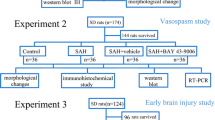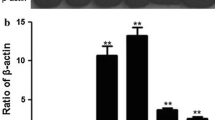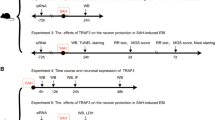Abstract
This study aimed to investigate the expression of the Nemo-like kinase (NLK) in the brain after experimental subarachnoid hemorrhage (SAH) in rats. A total of 90 rats were randomly divided into six groups: control group, day 1, day 3, day 5, day 7, and day 14. Day 1, day 3, day 5, day 7, and day 14 groups were all SAH groups in which the rats were killed on days 1, 3, 5, 7, and 14, respectively. In SAH groups, autologous arterial blood was injected into cisterna magna once on day 0. Cross-sectional area of basilar artery was measured by H&E staining. Immunostaining and immunoblotting experiments were performed to detect the expression of NLK protein. Real-time polymerase chain reaction was used to analyze the presence and quantity of NLK mRNA. The level of oxidative stress in the artery was also measured. The basilar arteries exhibited vasospasm after SAH and became the most severe on day 3. The expressions of NLK protein and mRNA were decreased remarkably in SAH groups compared with the control group. The down-regulated expression of NLK was detected after SAH and the low ebb was on day 3, which was oppositely the peak time of oxidative stress. The expression of NLK was present mainly in the neurons in the brain and smooth muscle cells in the basilar artery. NLK is decreasingly expressed in an opposite time-course to the development of cerebral vasospasm (CVS) and SAH-induced brain injury in this rat experimental model of SAH and these findings might have important implications during the administration of specific NLK agonist to prevent or reduce CVS or neuronal apoptosis caused by SAH.






Similar content being viewed by others
References
Sehba, F. A., Hou, J., Pluta, R. M., & Zhang, J. H. (2012). The importance of early brain injury after subarachnoid hemorrhage. Progress in Neurobiology, 97, 14–37.
Ardelt, A. (2012). From bench-to-bedside in catastrophic cerebrovascular disease: Development of drugs targeting the endothelin axis in subarachnoid hemorrhage-related vasospasm. Neurological Research, 34, 195–210.
Gokce, C., Gulsen, S., Yilmaz, C., Guven, G., Caner, H., et al. (2010). The effect of the sildenafil citrate on cerebral vasospasm and apoptosis following experimental subarachnoid hemorrhage in rats. Journal of Neurosurgical Sciences, 54, 29–37.
Wang, Y. X., Martin-McNulty, B., da Cunha, V., Vincelette, J., Lu, X., et al. (2005). Fasudil, a Rho-kinase inhibitor, attenuates angiotensin II-induced abdominal aortic aneurysm in apolipoprotein E-deficient mice by inhibiting apoptosis and proteolysis. Circulation, 111, 2219–2226.
Dreier, J. P., Drenckhahn, C., Woitzik, J., Major, S., Offenhauser, N., et al. (2013). Spreading ischemia after aneurysmal subarachnoid hemorrhage. Acta Neurochirurgica Supplement, 115, 125–129.
Kusaka, G., Ishikawa, M., Nanda, A., Granger, D. N., & Zhang, J. H. (2004). Signaling pathways for early brain injury after subarachnoid hemorrhage. Journal of Cerebral Blood Flow and Metabolism, 24, 916–925.
Ishitani, T. (2012). Protein kinase NLK, that fine-tunes the activity of multiple intracellular signaling pathways. Seikagaku, 84, 39–42.
Li, Z., Cui, G., Wang, J., Yu, Z., Zhao, L., et al. (2012). Nemo-like kinase (NLK) involves in neuronal apoptosis after traumatic brain injury. Cellular and Molecular Neurobiology, 32, 381–389.
Cui, G., Li, Z., Shao, B., Zhao, L., Zhou, Y., et al. (2011). Clinical and biological significance of nemo-like kinase expression in glioma. Journal of Clinical Neuroscience, 18, 271–275.
Zubkov, A. Y., Aoki, K., Parent, A. D., & Zhang, J. H. (2002). Preliminary study of the effects of caspase inhibitors on vasospasm in dog penetrating arteries. Life Sciences, 70, 3007–3018.
Zubkov, A. Y., Ogihara, K., Bernanke, D. H., Parent, A. D., & Zhang, J. (2000). Apoptosis of endothelial cells in vessels affected by cerebral vasospasm. Surgical Neurology, 53, 260–266.
Sabri, M., Kawashima, A., Ai, J., & Macdonald, R. L. (2008). Neuronal and astrocytic apoptosis after subarachnoid hemorrhage: A possible cause for poor prognosis. Brain Research, 1238, 163–171.
Brott, B. K., Pinsky, B. A., & Erikson, R. L. (1998). Nlk is a murine protein kinase related to Erk/MAP kinases and localized in the nucleus. Proceedings of the National Academy of Sciences USA, 95, 963–968.
Choi, K. W., & Benzer, S. (1994). Rotation of photoreceptor clusters in the developing Drosophila eye requires the nemo gene. Cell, 78, 125–136.
Ishitani, T. (1999). The TAK1-NLK-MAPK-related pathway antagonizes signalling between beta-catenin and transcription factor TCF. Nature, 399, 798–802.
Suzuki, H., Hasegawa, Y., Kanamaru, K., & Zhang, J. H. (2011). Mitogen-activated protein kinases in cerebral vasospasm after subarachnoid hemorrhage: A review. Acta Neurochirurgica Supplement, 110, 133–139.
Zhang, X., Zhao, X. D., Shi, J. X., & Yin, H. X. (2011). Inhibition of the p38 mitogen-activated protein kinase (MAPK) pathway attenuates cerebral vasospasm following experimental subarachnoid hemorrhage in rabbits. Annals of Clinical and Laboratory Science, 41, 244–250.
Kusaka, G., Ishikawa, M., Nanda, A., Granger, D. N., & Zhang, J. H. (2004). Signaling pathways for early brain injury after subarachnoid hemorrhage. Journal of Cerebral Blood Flow and Metabolism, 24, 916–925.
Matz, P. G., Fujimura, M., & Chan, P. H. (2000). Subarachnoid hemolysate produces DNA fragmentation in a pattern similar to apoptosis in mouse brain. Brain Research, 858, 312–319.
Ogihara, K., Zubkov, A. Y., Parent, A. D., & Zhang, J. H. (2000). Oxyhemoglobin produces necrosis in cultured smooth muscle cells. Acta Neurochirurgica Supplement, 76, 507–510.
Meguro, T., Chen, B., Lancon, J., & Zhang, J. H. (2001). Oxyhemoglobin induces caspase-mediated cell death in cerebral endothelial cells. Journal of Neurochemistry, 77, 1128–1135.
Pluta, R. M., Oldfield, E. H., & Boock, R. J. (1997). Reversal and prevention of cerebral vasospasm by intracarotid infusions of nitric oxide donors in a primate model of subarachnoid hemorrhage. Journal of Neurosurgery, 87, 746–751.
Bombeli, T., Karsan, A., Tait, J. F., & Harlan, J. M. (1997). Apoptotic vascular endothelial cells become procoagulant. Blood, 89, 2429–2442.
Macdonald, R. L., Weir, B. K., Runzer, T. D., Grace, M. G., Findlay, J. M., et al. (1991). Etiology of cerebral vasospasm in primates. Journal of Neurosurgery, 75, 415–424.
Zhou, C., Yamaguchi, M., Colohan, A. R., & Zhang, J. H. (2005). Role of p53 and apoptosis in cerebral vasospasm after experimental subarachnoid hemorrhage. Journal of Cerebral Blood Flow and Metabolism, 25, 572–582.
Zhou, C., Yamaguchi, M., Kusaka, G., Schonholz, C., & Nanda, A. (2004). Caspase inhibitors prevent endothelial apoptosis and cerebral vasospasm in dog model of experimental subarachnoid hemorrhage. Journal of Cerebral Blood Flow and Metabolism, 24, 419–431.
Cook, D. A., & Vollrath, B. (1995). Free radicals and intracellular events associated with cerebrovascular spasm. Cardiovascular Research, 30, 493–500.
Ayer, R. E., & Zhang, J. H. (2008). Oxidative stress in subarachnoid haemorrhage: Significance in acute brain injury and vasospasm. Acta Neurochirurgica Supplement, 104, 33–41.
Acknowledgments
This work was supported by Grants from the National Natural Science Foundation of China (No. 81171105, 81271300, and 81100872), Jiangsu Province’s Outstanding Medical Academic Leader program (NO. LJ201139), and Grants from Education Department of Jiangsu Province (No. 11KJB320011) and Suzhou Government (No. SYS201109).
Author information
Authors and Affiliations
Corresponding authors
Rights and permissions
About this article
Cite this article
Chen, G., Feng, D., Zhang, L. et al. Expression of Nemo-Like Kinase (NLK) in the Brain in a Rat Experimental Subarachnoid Hemorrhage Model. Cell Biochem Biophys 66, 671–680 (2013). https://doi.org/10.1007/s12013-012-9511-6
Published:
Issue Date:
DOI: https://doi.org/10.1007/s12013-012-9511-6




